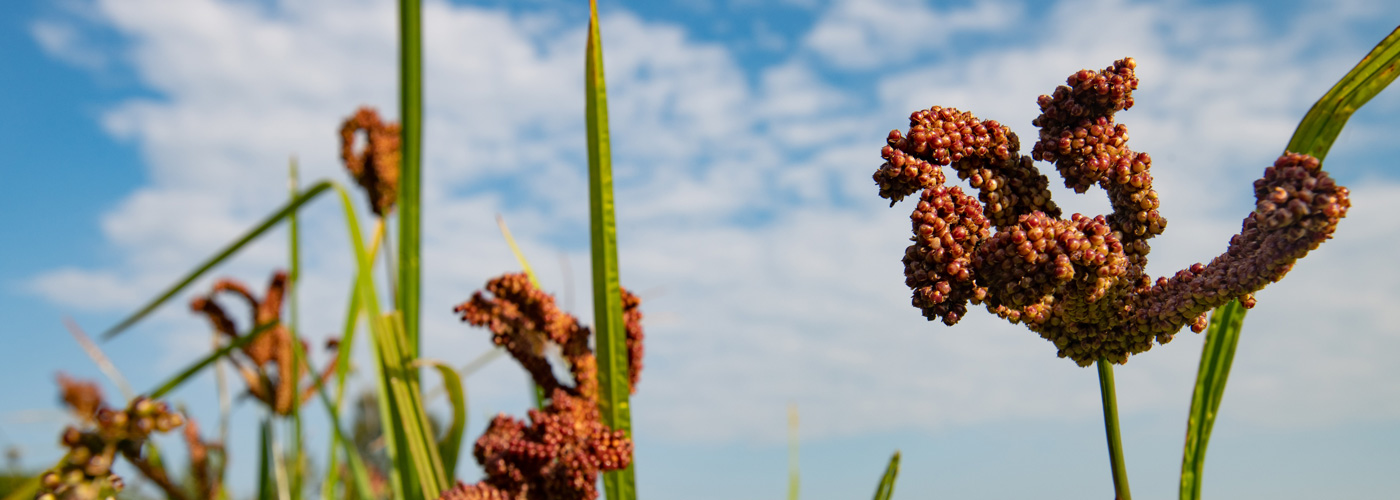Global Strategy for the Conservation and Use of Genetic Resources of Selected Millets
Global strategy for the conservation and use of genetic resources of selected millets: Covering pearl millet (Cenchrus americanus (L.) Morrone), finger millet (Eleusine coracana (L.) Gaertn.), foxtail millet (Setaria italica (L.) P. Beauv.), proso millet (Panicum miliaceum L.), barnyard millet (Echinochloa crus-galli (L.) P. Beauv. and Echinochloa colona (L.) Link),teff (Eragrostis tef (Zucc.) Trotter), fonio (Digitaria exilis Stapf. and Digitaria iburua Stapf.), little millet (Panicum sumatrense Roth. ex. Roem & Schult.) and kodo millet (Paspalum scrobiculatum (L.)). was published in 2023 (Global Crop Diversity Trust 2023, DOI: 10.5281/zenodo.7544810). This document, developed with the input of a large number of experts, aims to provide a framework for the efficient conservation and effective use of globally important collections of millet genetic resources. This webpage provides a summary of some of the its key findings and of the recommendations for priority actions.
Size of collections and their locations
An estimate of the total number of collections globally and the number of accessions they conserve for each crop is given in the table below
The estimate was based upon information obtained from FAO-WIEWS (2020), Genesys, the previous survey done in 2009, Dwivedi et al. (2012) and the responses to the current survey.
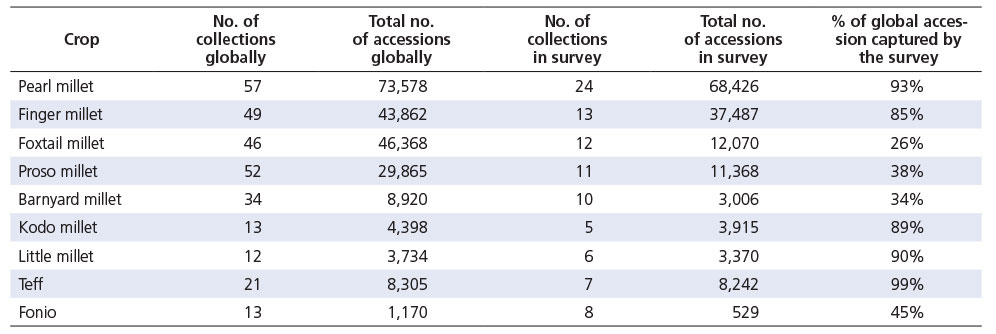
Current global system for the conservation and use of millet crops
The current global system for the conservation and use of millet crops consists of the following:
- Local farmers and households who conserve and manage the majority of these crops’ diversity.
- Natural areas where the majority of the diversity of wild relatives is still conserved.
- One international genebank, ICRISAT, which conserves a large collection of pearl millet, finger millet, foxtail millet, proso millet, barnyard millet, kodo millet and little millet, and which receives long-term support from the Global Crop Diversity Trust for secure conservation and wide availability of accession-level information and seed for users.
- A few key national collection holders in the center of diversity that conserve mainly unique local diversity for one or a few millet crops with uncertain national support for conservation and breeding/ research but with greater opportunities for local engagement with users for conservation and use.
- A few other national collections that are located outside the center(s) of diversity that conserve accessions that are duplicates of those held by others and that are conserved more securely, with greater availability of accession-level information and seed for a wide range of users; however, their support is national and, as national priorities change, they face an uncertain future for conservation and use given the decline in engagement with users.
Status of collections: routine operations
Trhough a survey, data was collected to assess the efficiency, effectiveness and security of the conservation of current ex situ collections.
The chart below shows the proportion (%) of accessions across all respondents to the survey that have been subject to routine operations: seed viability testing, seed health testing, determination of number of seeds conserved, regeneration, multiplication, and characterization.
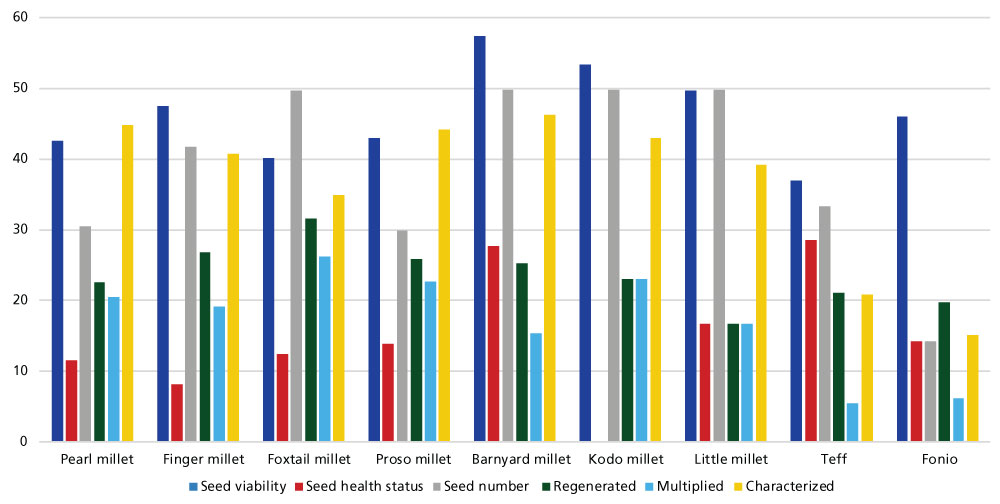
The chart below shows the proportion of respondents that had subjected 0%, 1–49%, 50–89% or 90–100% of their accessions to various routine operations: seed viability testing, seed health testing, determination of the seed number, regeneration, multiplication or characterization for minimal traits.
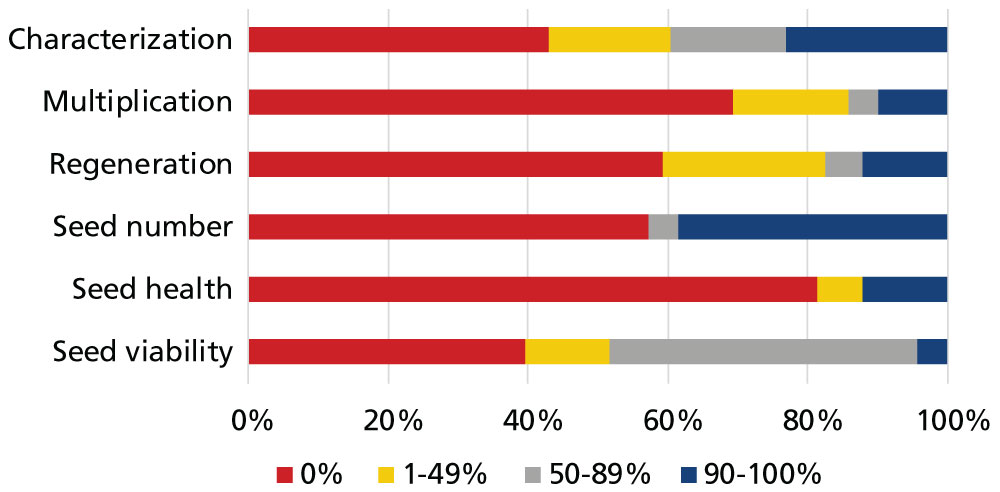
Safety duplication
Less than a quarter of the accessions conserved ex situ for these millet crops are safety duplicated in any site outside the original institute.
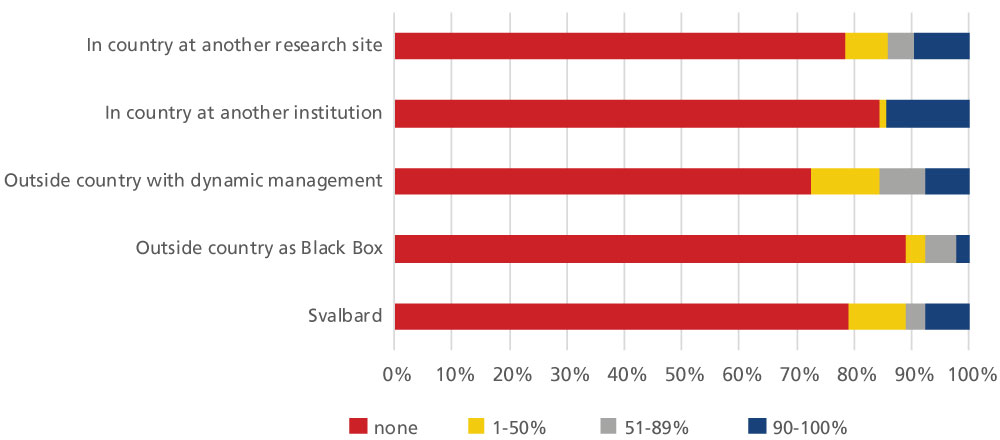
Documentation of ex situ collections
The chart below shows the proportion of respondents that have none of the accessions, 1–50% of accessions, 51–90% of accessions, or 90–100% of accessions with passport data; passport data in a searchable database; or characterization data in a searchable database. The y axis indicates the percentage of respondents (i.e. genebanks). The color of the bars indicates the proportion of accessions.
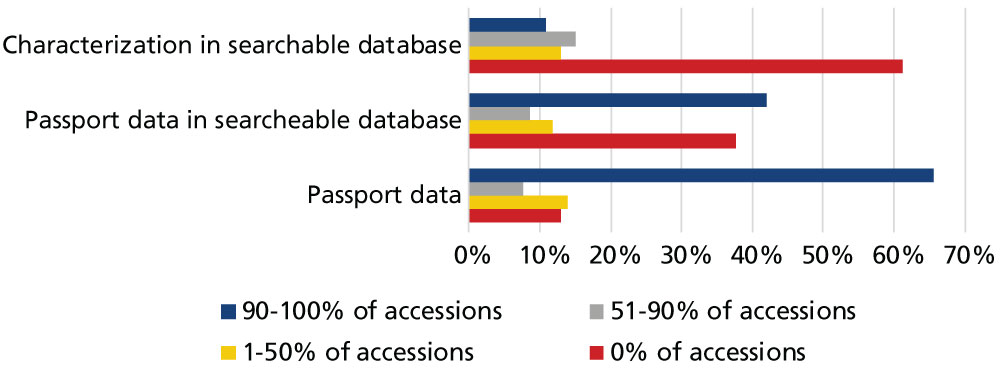
Use of ex situ collections
The chart below shows the frequency of distribution to various types of user, by proportion of respondents (no distribution or no requests in the past 5 years; one distribution in the past 5 years; one distribution per year; more than one distribution per year).
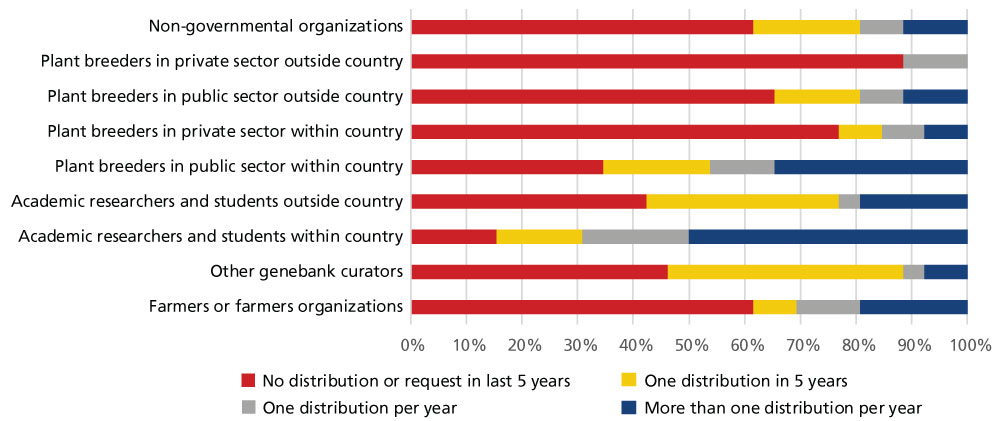
Recommendations for priority actions
This global strategy identifies three key strategic areas for priority actions, based on the survey findings:
- To secure the long-term conservation of millet crop genetic resources, with the main focus on addressing vulnerabilities in ex situ conservation caused by suboptimal routine operations, facilities and safety duplication; to address the risk of loss of unique diversity conserved only in farmers’ fields and in natural areas; to address constraints to global engagement between conservers and between conservers and users; and to increase com- munication on the importance of millet crops and their conservation.
- To increase the availability and exchange of germplasm, with the key focus on addressing constraints to distribution caused by insufficient seed quantity, quality and viability, and by technical and policy bottlenecks.
- To increase the use of genetic diversity in collections by: facilitating access to accession-level information, preferably by making it available online for all users; increasing evaluation and genotyping; making core collections or other subsets available to facilitate use; and increasing research and farmer engagement.
To address the key strategic areas, three priority actions have been identified, based on results of the survey and a background review:
- To establish a global platform to engage conservers and users.
- To establish a global fund to increase resources for upgrades and overall secure conservation of key national collections in the center of diversity.
- To establish a global initiative to secure the unique diversity of millet crops that exists only in farmers’ field or in natural areas.
Partners and donor
The development of this crop conservation strategy was funded by the German Federal Ministry of Food and Agriculture (BMEL) as part of the three-year project led by the Crop Trust: Breathing New Life into the Global Crop Conservation Strategies: Providing an Evidence Base for the Global System of Ex Situ Conservation of Crop Diversity. The Crop Trust also cooperated with the Secretariat of The International Treaty on Plant Genetic Resources for Food and Agriculture (ITPGRFA) in the development of this document.




